Eurofighter Typhoon versus Dassault Rafale: A 2020 comparison
Anmerkung Roger Harr: Derartige Vergleiche sind für die Schweiz immer wenig aussagekräftig, weil die spezifischen Schweizer Anforderungen nicht berücksichtigt werden und keine detaillierte Evaluation Basis für die gemachten Aussagen ist.

In 2015, Research Fellow at the RUSI Think-tank Justin Bronk, compared Europe’s two middle-weight fighter aircraft, the Typhoon and Rafale, The relatively subtle differences between these two superbly capable aircraft have inspired a great deal of heated debate, often poisoned by pride and nationalism. His article provoked a great huge response from readers around the world. We went back to Justin Bronk and asked him to revisit this analysis to include half a decade’s worth of development and weapons integration which has now placed these two aircraft at the top of their game.
Justin Bronk is a Research Fellow of Military Sciences at the Royal United Services Institute and Editor of RUSI Defence Systems.
What is the biggest difference in the philosophy of the designs?
“With common DNA in terms of initial development and requirements setting work before France spilt away from what became the Eurofighter consortium to develop the Rafale, it is unsurprising that both aircraft have relatively similar design philosophies compared to their competitors globally. The biggest source of differences comes from the French requirement that the basic airframe design be suitable for CATOBAR carrier operations, which carries particular requirements in terms of relatively high-alpha, low speed handling especially with external stores still attached. The Rafale was also designed from the outset as a nuclear delivery system, which was not a major consideration for the Eurofighter nations.
In terms of the design philosophy effects on the final aircraft, the Rafale has a greater emphasis on load carrying and exceptional handling even at very low speeds whilst the Typhoon as a design is more focused on maximum performance at altitude, and agility at transonic and supersonic speeds. This is all relative, however, as both aircraft perform very similarly in most scenarios compared to other types.
Radar
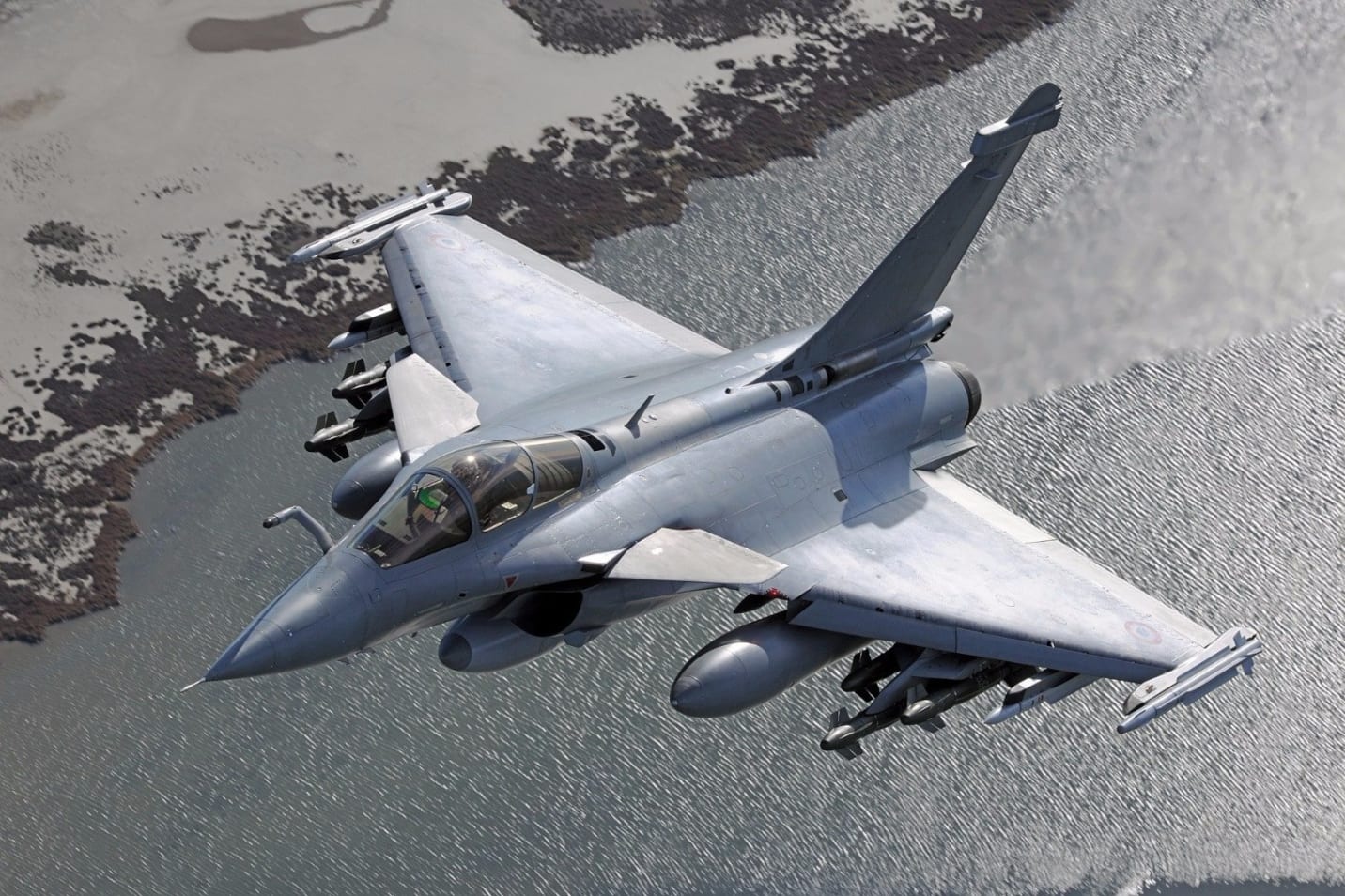
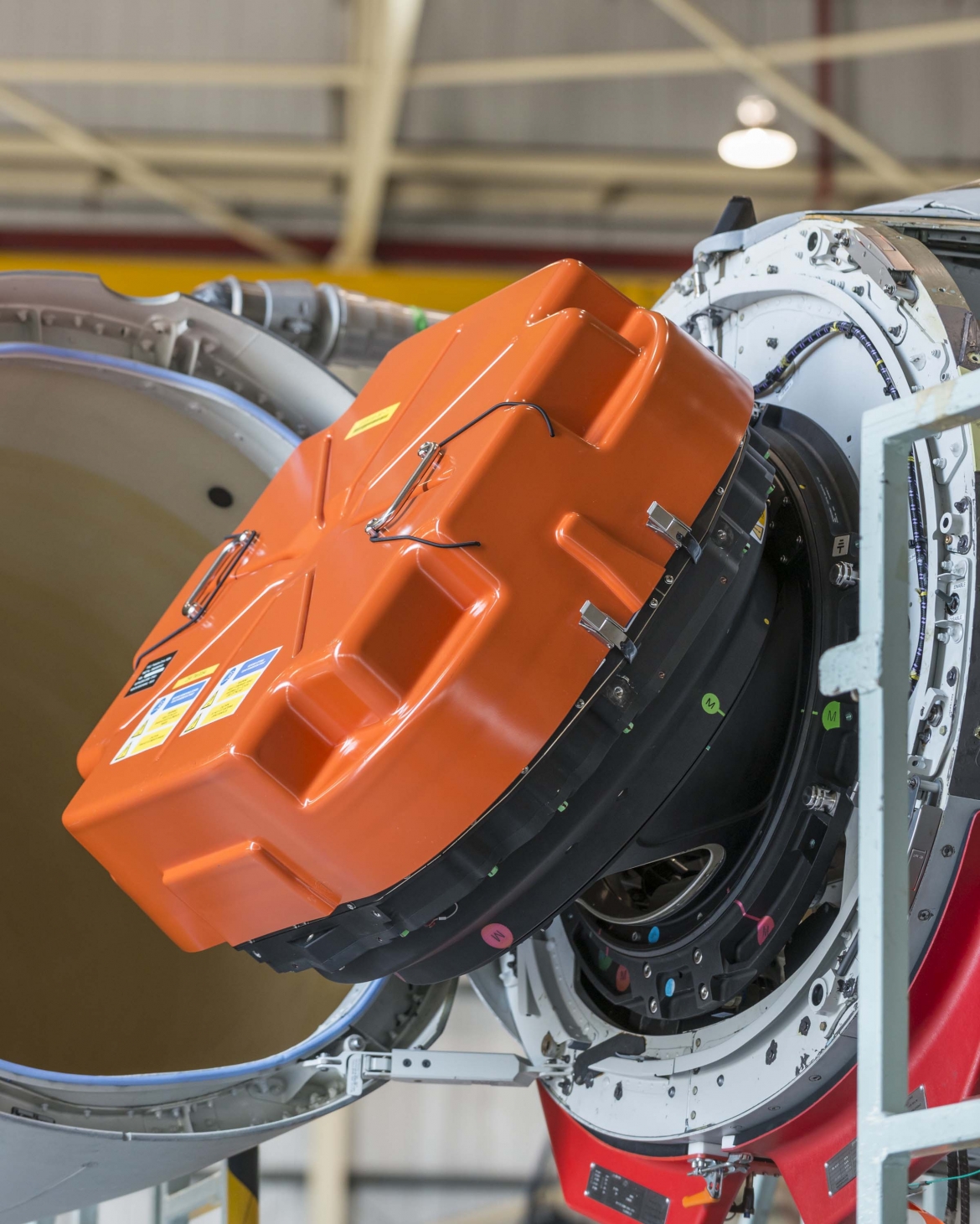
At time of writing the following comparisons would be for the latest F3R Standard Rafale with the RBE2 AESA radar vs a Typhoon FGR.4 in UK service with the CAPTOR-M. I will add an estimate in brackets for the Kuwaiti/Qatari standard Typhoon with the ‘Radar 0’ version of the CAPTOR-E AESA which is flying and enters service this year in Kuwait. For reference the German/Spanish ‘Radar 1’ standard will add further capabilities and the UK’s ECRS2 version will be a different beast entirely with advanced ground mapping, GMTI and EW capabilities in addition to traditional AESA functions. However, those will not be in service for several years so are not included here.
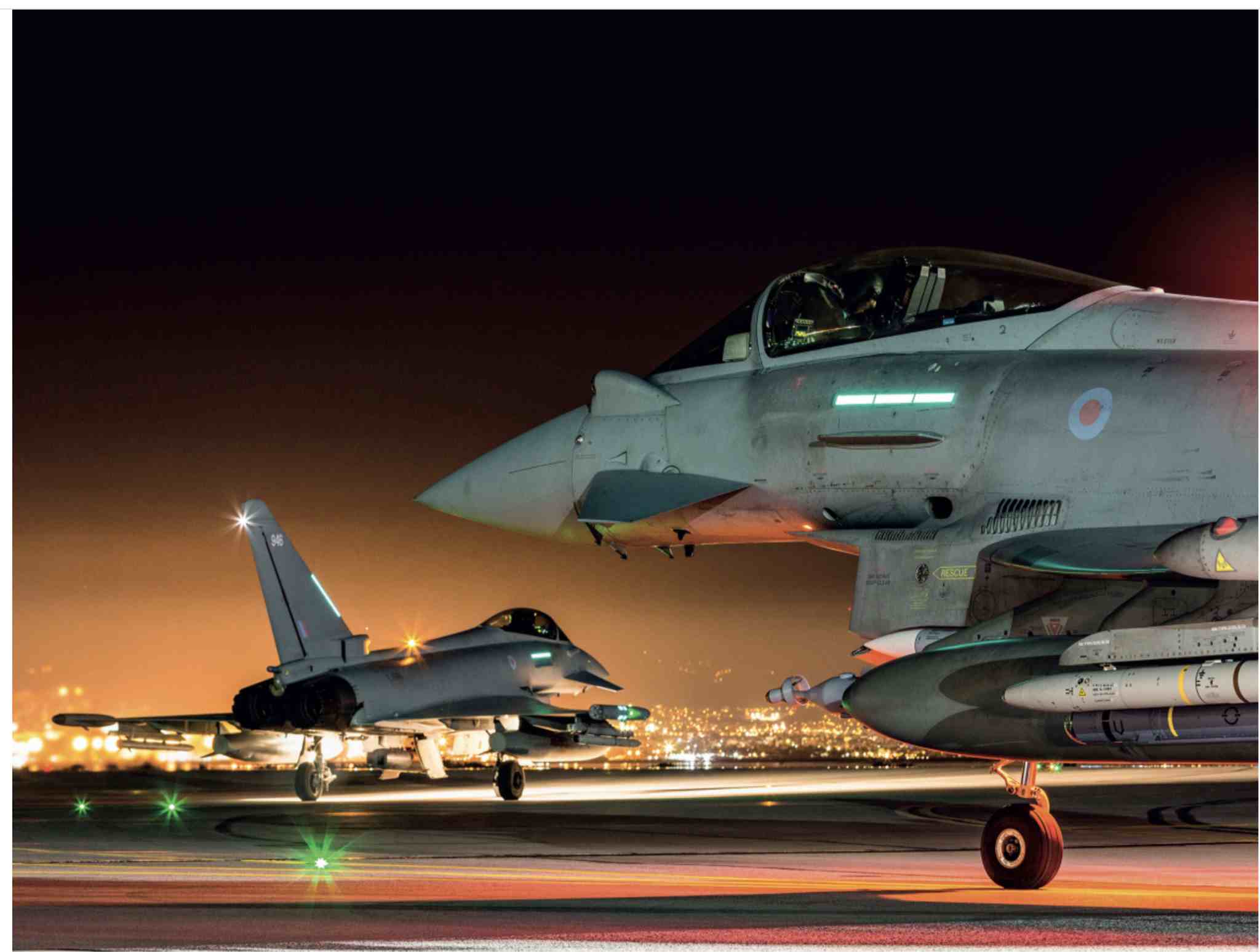
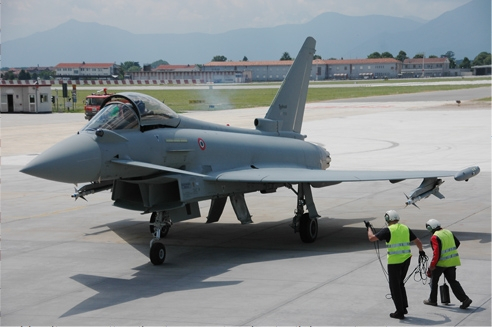
Air-to-air engagements at long ranges
The RBE2 (has the advantage) against targets with a low radar cross section due to the greater performance of AESA types against these threats. CAPTOR-M (has the advantage) against larger targets such as bombers or MiG-31 ‘Foxhound’s due to a much larger aperture and generally higher altitude perch during air-to-air engagements. (Radar 0 will out-range both against airborne targets)
Air-to-air engagements at short ranges and why?
RBE2 due to much faster AESA scan, acquisition and classification of target capabilities, greater resistance to dropping contacts during manoeuvres, as well as excellent information display for pilots in F3R cockpit. (RBE2 likely to still beat Radar 0 upon IOC due to more mature system and HMI).
Air-to-ground
RBE2 as a multifunction AESA radar gives far more air-to-ground functionality than CAPTOR-M. (Radar 0 is optimised for air-to-air and is unlikely to challenge RBE2 in this arena).
Maritime attack
RBE2 again due to advantages of AESA array plus a more mature maritime attack mode with Exocet integrated. Typhoon has anti-ship munition options but no current operators use them.
Which aircraft has a superior infra-red search and track system and why? Typhoon with the PIRATE system is significantly ahead of the legacy Rafale IRST. The latter was deleted from the latest F3R standard aircraft pending an updated capability in the F4 standard jets, leaving a laser rangefinder/EO ball only. PIRATE is a genuinely exceptional IRST, although for years shortages of spare parts limited its use by various frontline squadrons.
Cockpit layout/man-machine interface
Both aircraft have similar cockpit layouts in most respects, with three large main multifunction colour displays capable of significant customisation to suit individual pilot preferences in the latest versions. Both are significantly cleaner in terms of switches and clutter than previous generations of aircraft and slightly cleaner than current generation F-15s and F-16s in USAF service. A pilot from either of those two fighters would find little out of place or unfamiliar in terms of cockpit layout, although the internal menus and system logic may be different from what they are used to. By dint of being complex multi role single seat (in most cases) fighters, the HOTAS controls are fairly intimidating to someone used to a US teen series (or my DCS A-10C/F-16 HOTAS), but once mastered are extremely comprehensive. Having ‘flown’ full fidelity Typhoon simulators in Italy and the UK, including the latest Project Centurion multi-role standard now used by the RAF, I was impressed by the intuitive ‘feel’ of the human-machine interface (HMI) across various multi role tasks. Unfortunately I haven’t had the opportunity to do the same with the French Air Force (hint hint mes amis!). According to all the Rafale pilots I have spoken to, the Rafale’s F3R standard HMI is superb from an operator’s point of view in multirole scenarios, especially in terms of displaying threat information.
The central display protruding out towards the pilot in the Rafale would be a matter of personal taste over the more traditional Typhoon display layout, with an easier view of the main radar/situational awareness display coming at the cost of slightly reduced cockpit working area in a cockpit already slightly more snug than Typhoon’s. The Typhoon has an advantage in terms of a mature helmet mounted display (HMD) system in the form of the Striker helmet, and an extremely advanced follow on (the Striker II) is well into testing with integral night vision, multi role visual/voice target designation capabilities and other advancements. Meanwhile the new Qatari standard Rafales are being delivered with the type’s first HMD, but the French Air Force still lacks this capability, and the system is still to be matured.
Maintenance/sortie rates/operating costs/cost
Both fighters are fairly expensive to operate compared to solutions such as Gripen or F-16 on a one-for-one basis, being large, complex, twin engined beasts. The exact cost per flight hour (a hugely contentious topic anyway) will depend greatly on which operator and which version you are looking at. For example, Spanish Typhoons cost a great deal more to fly than British ones since the RAF flies its fleet a lot more and has more streamlined maintenance support arrangements. However, even within the RAF, the older Tranche 1s are much more costly to fly and difficult to maintain than the new Tranche 3s. Rafale operating costs and availability likewise varies across standards and operators. In extremely broad brush terms, French Rafales sit somewhere in the middle in terms of operating costs compared to Typhoon, being slightly more expensive than the UK’s Tranche 2 and 3 Typhoons under the TyTan support arrangements but cheaper than Spain or Germany’s Typhoons. For export operators, things are much more dependent on fleet size and support contract structures than the differences between each aircraft type.
Both types are highly tolerant of bad weather conditions although Rafale-M has an edge in terms of landing conditions tolerances due to the carrier-suitability adaptions.
In terms of unit cost, Rafale is marketed as cheaper than the latest standards of Typhoon, although the Indian experience would suggest that in practice export customer requirements on industrial offsets and liability can dramatically alter costs compared to the up-front offer, so I’d be wary of comparing public cost claims from either manufacturer. The actual cost will depend on the govt-govt relationship and how many of the bells and whistles each customer wants to pay for. However, as a rule Rafale is probably slightly cheaper in real terms to acquire than Typhoon.
Low-observability
Both Rafale and Typhoon have low observable features but quite frankly neither is a low observable type. Completely slicked off with no external stores or targeting pods, a Rafale would likely have a lower frontal RCS compared to a Typhoon, but in practice neither would be combat effective in this configuration. With external pylons, tanks, weapons and pods, both have a sufficient RCS to be detected at long ranges by modern sensors such as the Irbis-E on the Su-35 and Chinese AESAs on J-10C, J-16 or J-20, as well as ground based air defence radars.
Aerodynamics and performance
It is said that the Rafale would have an advantage in a dogfight below 10K feet and a Typhoon above, would you agree with this?
In within-visual range combat, both Typhoon and Rafale would likely destroy each other in the merge in a 1v1 or 2v2. However, if talking about a ‘guns’ fight, then Rafale has better agility, instantaneous turn and sustained turn capabilities below around 15,000ft. Between 15,000 and around 30,000ft the relative merits will depend on speed range, as if the Typhoon might start with an advantage in a supersonic merge but Rafale would improve relatively as speeds drop during a long engagement. In practice it would depend on pilot experience and skill to fly their aircraft at best corner speed and manage their energy and position to best effect. At higher altitudes, Typhoon’s greater specific excess power and decoupled canards give it a slight advantage, which increases as altitude increases above 45,000ft.
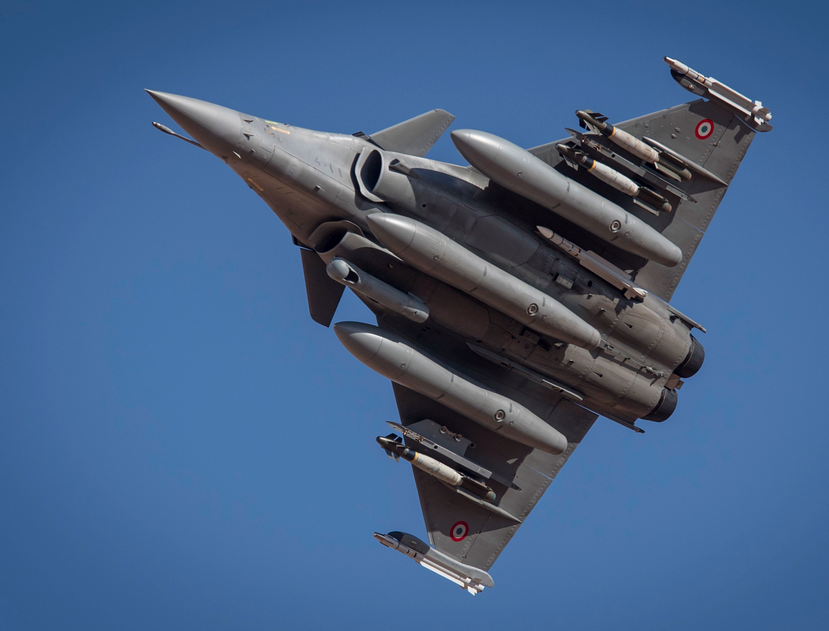
What is Typhoon’s configuration designed to excel at, and the same for Rafale? Typhoon is designed to excel in acceleration, climb rate and supersonic performance and agility at high altitudes for maximum beyond visual range capability. Rafale is designed to excel at subsonic speeds and at lower altitudes. It is still a brutal performer compared to most other fighters, but cannot match Typhoon’s climb rate and brute thrust especially at higher altitudes. With heavy loads, however, Rafale performs significantly better than Typhoon across the almost the entire performance envelope, having been designed from the outset to incorporate heavy multirole loads. Typhoon’s flight control software starts to progressively restrict the jet with heavier (or particularly asymmetric) loads. The Aerodynamic Modification Kit (AMK) developed by Eurofighter would address these limitations and greatly improve the instantaneous turn rate and agility at all speeds with heavy loads, but so far no operator has bought it – suggesting they are broadly satisfied with the aircraft as is.
High alpha performance
Neither aircraft sparkles in the high-alpha regime compared to the Hornet family or anything with thrust vectoring, but the Rafale’s aerodynamically coupled canards give it slightly better high-alpha authority at slow speeds than Typhoon.
Abilities at different altitudes
The lower the altitude, the greater Rafale’s margin of advantage; the higher one goes, the better Typhoon performs relatively. Typhoon is happiest at 50,000ft and above.
Sustained/Instantaneous turn rates
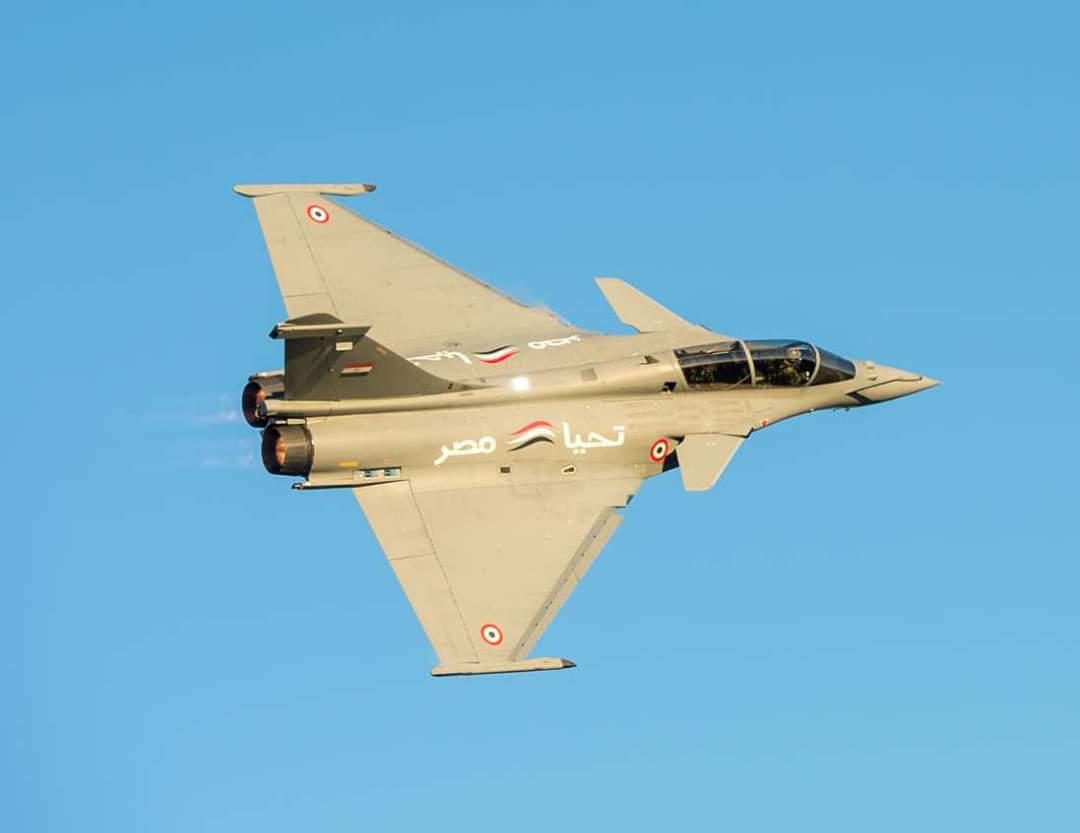
Depends on altitude and speed. As above, the higher the speed and altitude of an engagement, the better Typhoon performs relative to Rafale and vice versa. In terms of instantaneous turn rate, Rafale has a slight advantage in air combat configuration and that increases with heavier multirole or strike loads.
Energy management/ ability to regenerate energy
Both fighters will pull 9G all day long in air combat configuration at most altitudes. At low altitudes Rafale’s energy retention is slightly better at best corner speed, whilst at higher altitudes Typhoon has better energy retention. In terms of energy regeneration, Typhoon has the edge by dint of a higher specific excess power.
Range and endurance
Both types have a similar ferry range with a ‘heavy’ three tank fit. However, Typhoon also uses a lot more fuel in afterburner so for mission profiles that involve a lot of AB use, Rafale will likely have the edge. In practice, both types depend to a large degree on tanker support for most operational missions.
Weapons
AMRAAM versus MICA
The AIM-120C7 and AIM-120D variants of AMRAAM used by RAF Typhoons significantly outrange MICA, although they do no boast an IR variant for passive BVR engagement capabilities. The flip side is that both AMRAAM variants have advanced off-board guidance capabilities to allow passive engagements in cooperation with another aircraft in active mode. US development efforts have emphasised these cooperative engagement capabilities (CEC) far more than French ones over the past two decades, and Typhoon benefits from that weapon heritage.
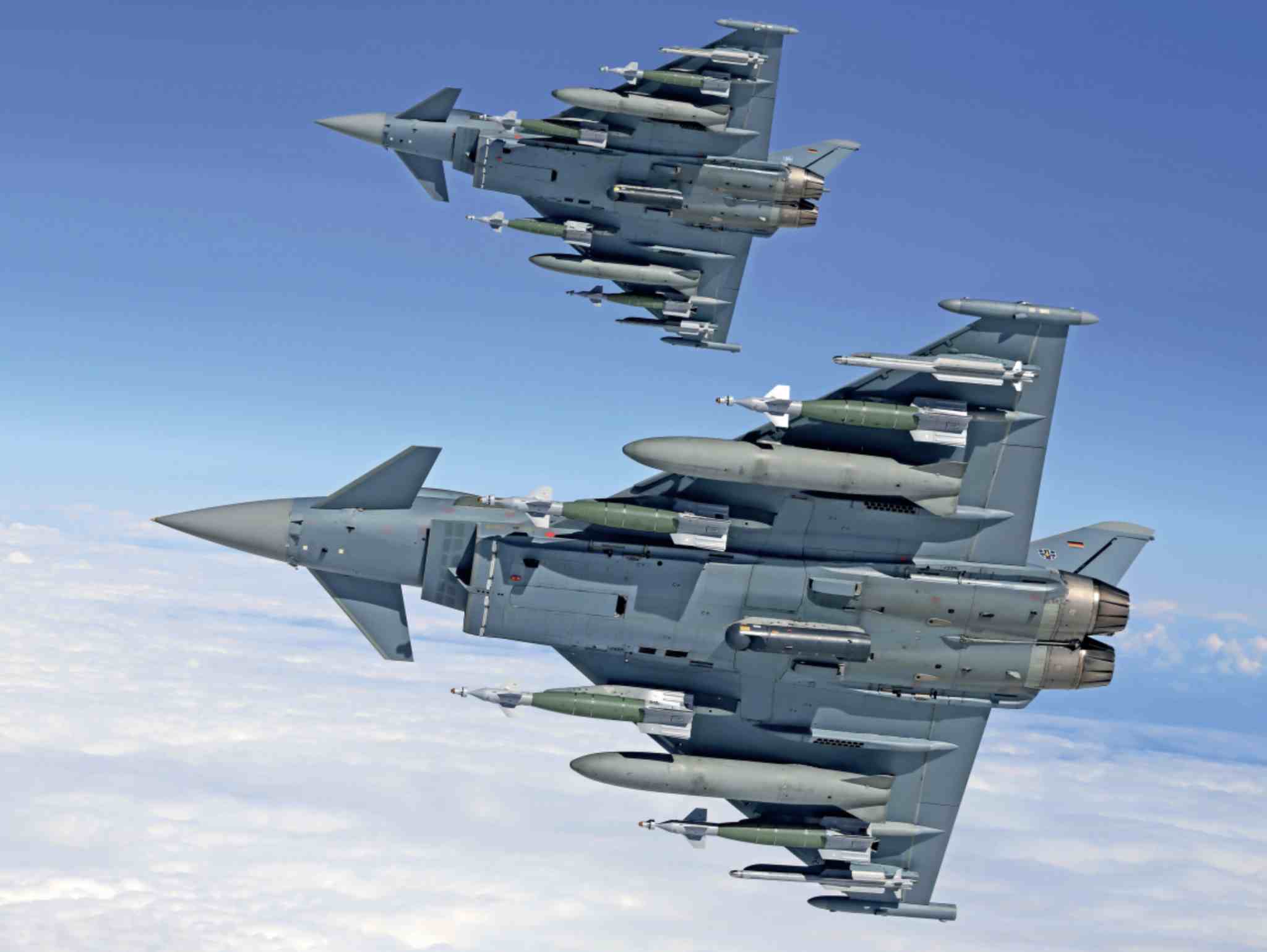
ASRAAM/IRIS-T versus MICA
MICA has slightly superior range to ASRAAM and significantly superior range to IRIS-T. All are highly agile and lethal missiles in a WVR engagement, with IRIS-T boasting the greatest knife fight agility, ASRAAM the best performance off the rail, and MICA the best reach. The lack of a helmet mounted sight for Rafale until the Qatari standard has meant that in practice Typhoon users may be able to get more out of IRIS-T or ASRAAM in a dynamic WVR engagement.
BK27 versus GIAT cannon
Both are devastating revolver cannons with selectable rates of fire. The GIAT has the advantage in maximum possible firing rate (of 2500rpm vs 1700rpm) although in practice both would likely fire at comparable rates for both air-to-air or air-to-ground use to make best use of very limited ammunition (125 rounds for Rafale, 150 for Typhoon). As revolver cannons, both reach their maximum fire rate almost immediately. The BK27 has slightly better muzzle velocity and ballistic properties whilst the GIAT has slightly better destructive effect due to its larger shell. In practice, there is little to choose between them, I pity the enemy shot at by either.
Air-to-ground munitions

Typhoon (Tranche 2 and 3)’s main strike armament of Paveway IV, Brimstone and Storm Shadow give it world-leading high-precision, low-collateral damage tools for most ground targets. It can also carry other munitions including the US Paveway II and III series of laser-guided bombs, and has been cleared for the AGM-88 HARM and British ALARM anti-radiation missiles although these are not in operational service. The ongoing flight trials of the SPEAR 3 multirole light standoff munition (which includes an EW variant for stand-in jamming) on UK Typhoons give the type access to another highly potent option, although at present the UK is only paying to actually use SPEAR 3 on F-35B. France’s AASM ‘Hammer’ series of glide and boosted bomb guidance kits gives Rafale a comparable capability to Paveway IV with a greater amount of warhead and range flexibility. The drawback is extremely high munitions cost. At the lower end, the Rafale can also carry and deliver the US made Paveway II and III series and like Typhoon is cleared to carry but does not currently use a range of other US munitions.
Recce equipment
Typhoon (and Rafale) have to make do with less than fully optimised TAC-R pods as the RAPTOR pod fitted to Tornado GR.4 was not integrated onto Typhoon when the latter was retired – in part because of centreline store size limitations on Typhoon due to the front landing gear leg placement. Rafale uses the Damocles targeting pod for light recce duties whilst RAF Typhoons use the Lightning III which also has limited FOV recon capabilities. Other Typhoon users employ the Damocles pod (Saudi Arabia) and the Sniper pod (Kuwait). The Damocles pod has an advantage over Sniper and Lightning III in that it features an integral datalink capability to transfer reconnaissance and target data directly to other stations such as those found on French Air Force tankers. In practice, however, Typhoon users with Sniper or Lightning III can off-board data using the jet’s own data-links.
Brimstone versus Hammer
Brimstone is more accurate with a much smaller ultra-low collateral warhead. AASM is dependent on either IR or laser-guidance to hit moving targets, rendering it more sensitive to adverse conditions than Brimstone’s millimetric wave radar seeker/laser dual mode guidance option. Brimstone’s smaller size also allows more weapons to be carried per aircraft, with three per hardpoint on adaptors. However, Brimstone is not designed to produce area effects or destroy structures, so for such targets the AASM family provides far more capability, especially with the larger ‘bomb’ body variants. For such targets, Typhoon users would employ Paveway II/III/IV series weapons.
Cruise missile capability
Rafale’s SCALP and Typhoon’s Storm Shadow are essentially the same (extremely capable but very expensive) missile from MBDA. Germany has cleared its Taurus KEPD 350 cruise missile but since German politicians do not believe that Air Forces should be used to kill people, its capabilities remain untested in combat. The French Rafales can also carry the ASMP-A nuclear standoff missile which is a unique capability.
Defence suppression/anti shipping

Both Typhoon and Rafale lack a commonly carried anti-radiation missile, although modern AAM such as AMRAAM and Meteor can be assumed to have a certain degree of ARM capability in extremis. Rafale has a superior ECM (electronic attack) capability in the shape of the SPECTRA suite allowing it more options to degrade the performance of hostile SAM radars if it needs to penetrate defended airspace. Typhoon users will have to wait for the UK-developed ECRS2 radar and DAS upgrade for a competitive or even (potentially) superior option. Both Typhoon and Rafale can launch capable standoff cruise missiles in the shape of the Storm Shadow/SCALP and Taurus KEPD 350. However, to have a decent probability of kill against modern long range air defence radars, these missiles require accurate real time target location data. This is because modern SAM systems such as the S-400 and HQ-9 are highly mobile and have such long range that a subsonic cruise missile launched from a safe distance would take tens of minutes to arrive. As such, both Typhoon and Rafale could make a very valuable contribution to a SEAD/DEAD operation in support of more stealthy penetrating ISTAR/strike assets such as F-35 or advanced UAVs, but if hypothetically forced to fight alone neither is particularly well suited at present – Rafale having a slight edge due to the SPECTRA suite.
Meteor
I’m not 100% sure if Rafale can now use the full two-way datalink functionality on Meteor. I think that is now enabled. Typhoon’s habit of fighting at very high speeds and altitude for BVR engagements will result in a longer effective range on Meteor shots, but in practice there are almost no scenarios short of a full scale war with Russia where the rules of engagement would allow shots at such a range where that difference would tell. Both can use third party target data to launch Meteor without active radar scanning by the launch aircraft, and both can hand off guidance in flight to other friendly assets. The UK’s Typhoons in particular are more closely integrated with the USAF air dominance community than (any) other fighter arm so have more practice in getting the most out of cooperative engagements with F-22s in realistic training scenarios.
How frequently is Meteor actually carried in 2020?
Tranche 2 and 3 Typhoons regularly carry Meteor on live operational sorties with European users, although the Tranche 1s do not use the missile which is why the RAF purchased the latest AIM-120D for its remaining Tranche 1s. For Rafale, Meteor is regularly carried by the F3R standard aircraft on live operational sorties by both the Armee de l’Air and Aeronavale.
How many Meteors are carried on a single-aircraft in everyday service?
RAF Typhoons and French Air Force Rafales typically carry two Meteors when flying with the missile.
How many Meteor could be carried in a wartime emergency?
The wartime load-out for Typhoon would by four Meteor in semi-recessed fuselage mounts plus four ASRAAM/IRIS-T although in practice a mix of Meteor and AMRAAM might be chosen for additional tactical flexibility and stockpile management. As far as I’m aware the Rafale has so far only been cleared for Meteor carriage on the two side-fuselage hardpoints although I could be wrong on that. If it was a priority to up the Meteor carriage on Rafale to four, I expect that could be done at the cost of MICA numbers on the centre underwing station.
Sensor fusion
Both Rafale F3R and P3E standard (Centurion upgraded) Typhoons present pilots with an intuitive combined situational awareness display which integrates data from multiple sensors. In that sense, both feature sensor fusion and represent a significant upgrade compared to legacy aircraft and previous Rafale and Typhoon standards. However, neither truly does the F-35’s signature trick of feeding the raw sensor inputs into a complex analytical process which cross references data from and cross cues not only each sensor on the jet but also those across a formation of F-35s, before presenting a processed single SA picture to the pilot. There’s a reason (beyond the undoubted inefficiencies and concurrency) why the US have had to put nearly half a trillion dollars into the F-35 programme to date, mostly aimed at getting the nightmarishly ambitious and complex software architecture to work. They’re trying to do something much more ambitious; although in many scenarios the output is functionally similar.
Defensive aids
SPECTRA has a better reputation primarily because of Libya in 2011 (a result of French political ambition and risk tolerance, alongside technical capability). However, it is a highly capable defensive aids suite, with greater strength on the ECM area of the ESM/ECM/ECCM EW triad compared to Typhoon’s DAS which is notable in the quality of its ESM (passive detection, ID and tracking of threats). The Indian standard Rafales come with a Towed Radar Decoy (TRD) but the French aircraft currently lack this feature. Typhoon comes with one or two TRDs mounted in a wingtip pod as standard, with specific version dependent on operator choices. The UK’s new Britecloud active radar ‘chaff’ countermeasures are another area where Typhoon is potentially somewhat in the lead on DAS features.
The leaked Swiss evaluation rated Rafale superior in almost every category- would this still be the case?
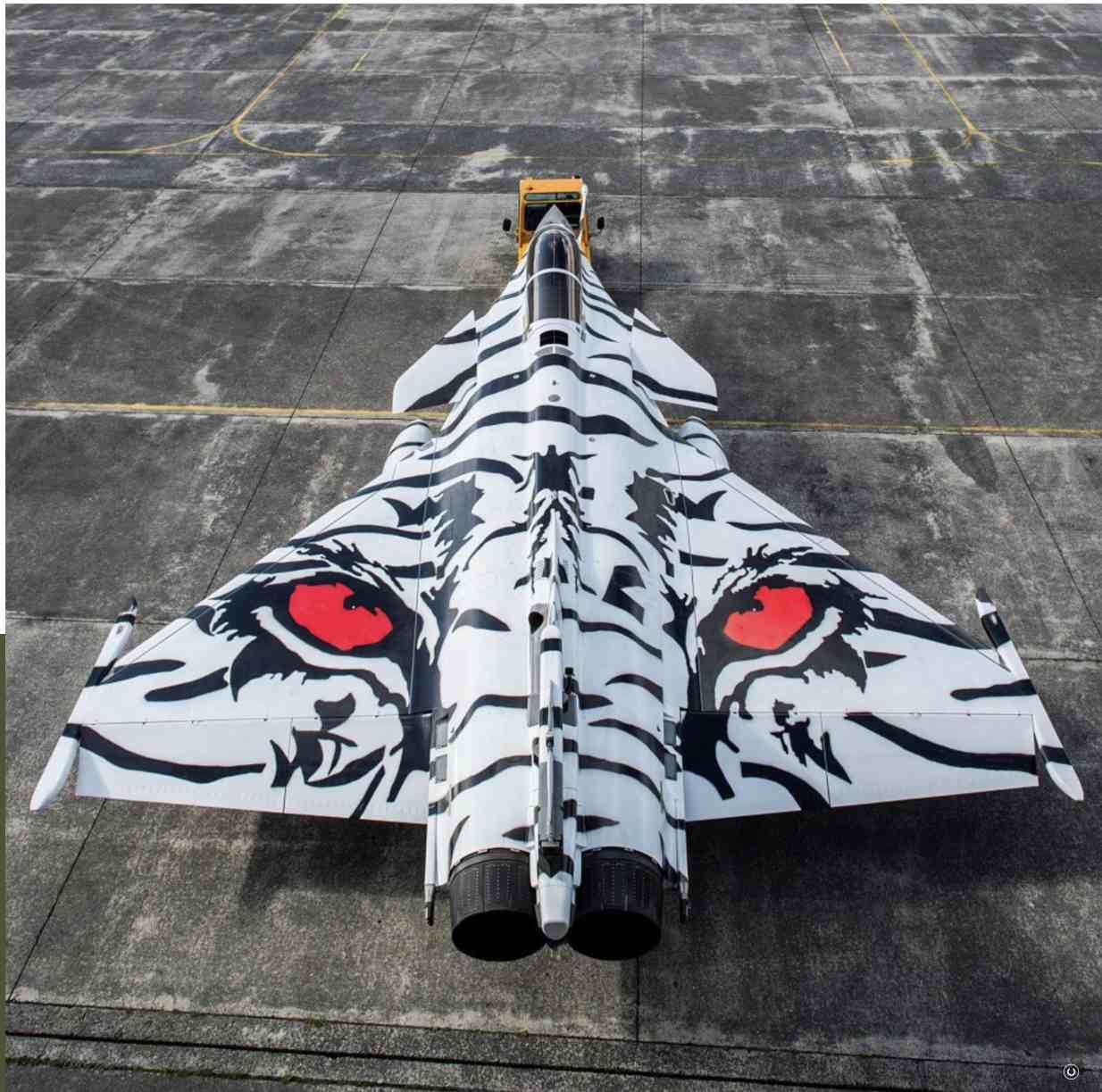
The Swiss competition was horrendously mismanaged by the Eurofighter consortium with a buggy Tranche 1 jet sent to compete with the best that Saab and Dassault could bring to the table. However, in terms of radar, the Rafale would still come out ahead due to its mature RBE2. In terms of load carrying capacity, ECM, subsonic agility, low and medium altitude WVR performance and cost Rafale F3R would also likely still come out ahead of a Tranche 2 or 3 P3E standard Typhoon. However, an RAF standard Tranche 3 Typhoon would likely come out ahead on BVR performance, interceptor missions (due to extreme rate of climb and performance), ESM, terminal countermeasures and low-collateral strike capabilities. Frankly, Switzerland should be flying Gripen C/D or possibly E/F given their national budget, neutrality and mission requirements and I’d wager anyone who looks at it from an operational requirements point of view would come to a similar conclusion. Shame about the whole referendum thing for the Swiss Air Force.
Kommentar Roger Harr, weil wir immer wieder auf die letzte Evaluation angesprochen werden: Die Evaluation 2008 ist mit der aktuellen Evaluation nicht vergleichbar. Die damaligen Versionen der Rafale und des Eurofighters entsprachen nicht den heutigen. Zudem waren auch die Anforderungsprofile vor mehr als 10 Jahren nicht mit den heutigen vergleichbar. Im Jahr 2008 bestand die Evaluation aus zwei Teilen. Der erste Teil basierte auf der fliegerischen Evaluation und der zweite Teil auf zusätzlichen Informationen über Kapazitäten, welche die Hersteller für die Auslieferung 2015 versprachen.

In den Bereichen Air Policing, Defensive Counter Air und Offensive Counter Air (OCA war der Gripen schlechter als der F/A-18 C/D Hornet, den er hätte ersetzen sollen. In den Bereichen Luftaufklärung und Air to Ground wurden die Minimalanforderungen nicht erfüllt.
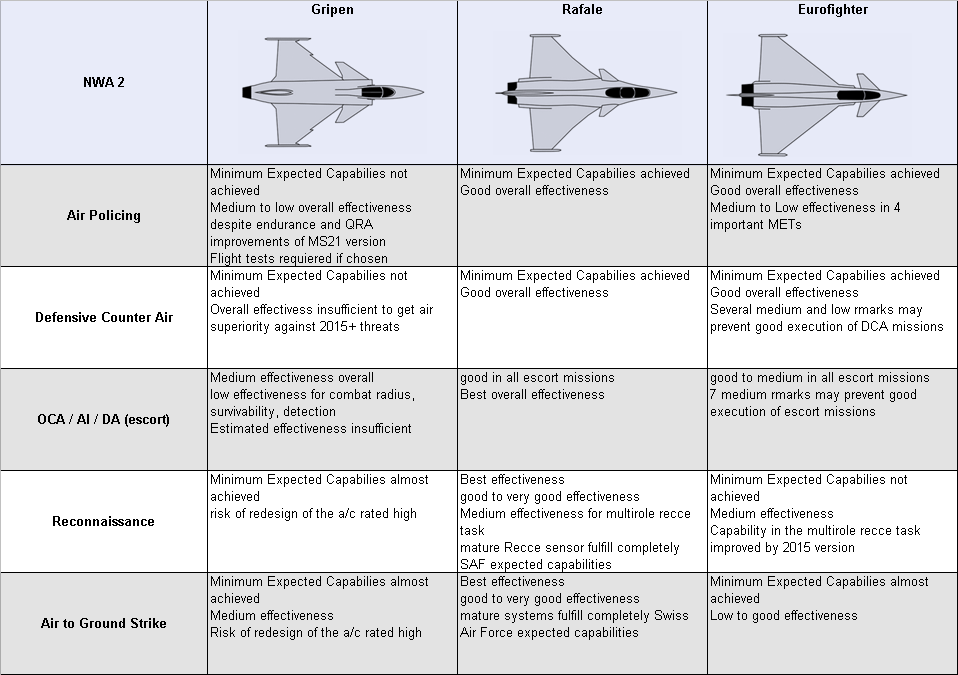

Wenn der Autor des Vergleichs Eurofighter Typhoon versus Rafale Justin Bronk der Schweiz empfiehlt, den Gripen zu beschaffen, dann hat er nicht realisiert, wofür die Schweiz das neue Kampfflugzeug NKF braucht. Der Gripen hat weder in seiner Version C/D noch E/F, die Schweizer Anforderungen erfüllt.
Die offizielle Begründung des Bundesrates für den Typenentscheid vom 30.11.2011 weicht von den geleakten Evaluationsdokumenten ab: „Als Kandidaten für das neue Kampfflugzeug der Schweiz standen drei Flugzeugtypen zur Auswahl: der Rafale der französischen Firma Dassault, der Eurofighter des europäischen Konsortiums EADS/Cassidian und der Gripen der schwedischen Firma Saab. Das VBS hat alle drei Flugzeugtypen einer umfassenden, mehrjährigen Evaluation unterzogen. Dabei hat sich gezeigt, dass alle drei Modelle die an sie gestellten Anforderungen erfüllen und deshalb als neues Kampfflugzeug für die Schweiz in Frage kämen.“
Es war somit ein rein politischer Entscheid.
How has Typhoon improved since your 2015 assessment?
The multirole capabilities of the jet have matured drastically since 2015, especially as a result of the RAF’s Project Centurion programme which integrated Brimstone, full Paveway IV functionality and Storm Shadow, in addition to full Striker HMD exploitation and a number of other multirole enabling capabilities. The integration of full Meteor capability and upgrades to the UK’s ESM capabilities within the DAS are also a big boost. The fact that Kuwaiti Typhoons are already flying with the export AESA is a welcome but long overdue improvement but Typhoon really continues to lag in terms of exploitation of its huge potential (given the massive nose aperture and power available) in the AESA department.
The German/Spanish Radar 1 order will, however, mean that there are a large number of AESA equipped Typhoons in service by the mid-2020s with all the Quadriga and Tornado replacement Typhoons to feature the capability. The UK’s much more ambitious (and now funded) ECRS2 promises a massive leap in AESA capability with areas of advantage even over the latest US AESAs, but is so far only likely to be integrated onto the 40 Tranche 3s, with the fate of the 67 Tranche 2s less certain in that regard.
Rafale improved since your 2015 assessment?
The integration of the Meteor missile for the F3R standard Rafales has plugged a major weakness of the type in my 2015 assessments – the lack of a serious BVR stick. The RBE2 radar has continued to mature and is now a standout feature of the jet, whilst the French government has committed to a major upgrade of the jet’s internal systems and sensors in the upcoming F4 standard programme. This means that the Rafale will continue to improve, especially in the EW and sensor fusion department throughout the 2020s.
What is the best Typhoon variant today and why?
The RAF’s Tranche 3 jets. With the Centurion upgrades, Meteor integration and an extremely experienced user community both in terms of strike/multirole missions and air superiority, the RAF’s Tranche 3 Typhoons would edge out the Kuwaiti and Qatari aircraft in terms of operational capability, even though the latter feature the export version of the CAPTOR-E radar series.
What is the best Rafale variant today and why?
That’s tricky to say. The Indian standard does feature some impressive additions including additional podded electronic warfare capabilities and TRD, whilst the Qatari standard features the new HMD. Both include the RBE2 although it is likely to be an export standard that is slightly de-tuned compared to French aircraft. The French Air Force’s latest F3R aircraft with the RBE2 and Meteor are, on balance, likely to be the most capable Rafales around for much the same reasons as the RAF’s Tranche 3 Typhoons are. Highly experienced crews, full DAS and radar capabilities without export restrictions (and a nuclear missile capability).
Which is doing better on the export market and why?
Rafale has had some impressive success on the export market since 2015, with the combination of RBE2 radar, combat record in Libya and aggressive French state support for marketing efforts contributing to success in Egypt, Qatar and Greece. Typhoon has had successes in Qatar and Kuwait, and a signature of intent from Saudi Arabia for another 48 aircraft soon. However, the biggest win in recent years is for Typhoon from Germany for both the Quadriga-standard replacement order for the Tranche 1s and also 90 aircraft to replace Germany’s Tornado fleet in the conventional strike role. This doesn’t really count as an export success though. Finland will be an interesting result to watch, but I’m not sure either aircraft could be considered a favourite.
What should I have asked you?
Which aircraft would fare better against the Flanker family and other aircraft likely to be flown by near-peer competitors such as the Chinese J-10 family? After all, Typhoon and Rafale were not built to fight each other, and will not do so. Their job is to deter and if necessary provide overmatch against the latest hostile fighter types. In this role, the Typhoon is probably the standout with its superior BVR capabilities in a large scale, open ROE engagement, but up close in a flashpoint around a QRA interception Rafale might have the edge. In a complex battlespace with dense ground based as well as aerial threats, both Typhoon and Rafale are formidable assets but would rely on support from dedicated penetrating and stand-off assets to minimise risk and truly perform at their best.


